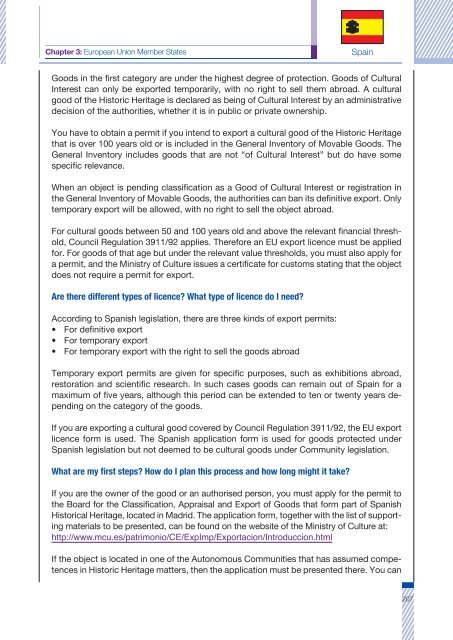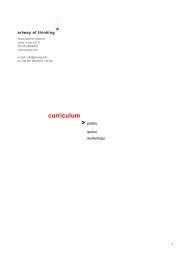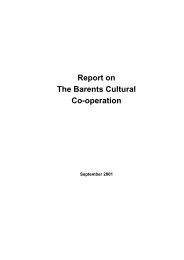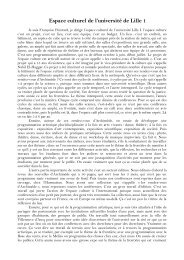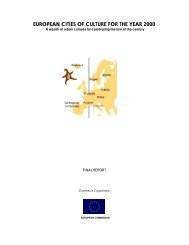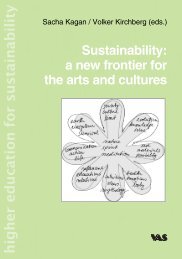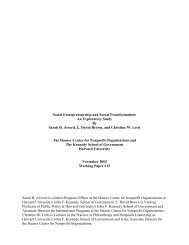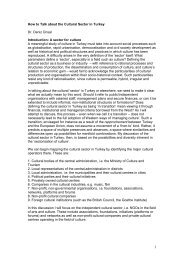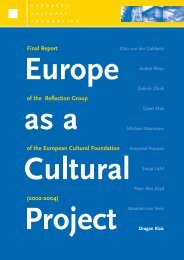A guide to the export and import of cultural goods between Russia ...
A guide to the export and import of cultural goods between Russia ...
A guide to the export and import of cultural goods between Russia ...
Create successful ePaper yourself
Turn your PDF publications into a flip-book with our unique Google optimized e-Paper software.
Chapter 3: European Union Member States<br />
Spain<br />
Goods in <strong>the</strong> first category are under <strong>the</strong> highest degree <strong>of</strong> protection. Goods <strong>of</strong> Cultural<br />
Interest can only be <strong>export</strong>ed temporarily, with no right <strong>to</strong> sell <strong>the</strong>m abroad. A <strong>cultural</strong><br />
good <strong>of</strong> <strong>the</strong> His<strong>to</strong>ric Heritage is declared as being <strong>of</strong> Cultural Interest by an administrative<br />
decision <strong>of</strong> <strong>the</strong> authorities, whe<strong>the</strong>r it is in public or private ownership.<br />
You have <strong>to</strong> obtain a permit if you intend <strong>to</strong> <strong>export</strong> a <strong>cultural</strong> good <strong>of</strong> <strong>the</strong> His<strong>to</strong>ric Heritage<br />
that is over 100 years old or is included in <strong>the</strong> General Inven<strong>to</strong>ry <strong>of</strong> Movable Goods. The<br />
General Inven<strong>to</strong>ry includes <strong>goods</strong> that are not “<strong>of</strong> Cultural Interest” but do have some<br />
specific relevance.<br />
When an object is pending classification as a Good <strong>of</strong> Cultural Interest or registration in<br />
<strong>the</strong> General Inven<strong>to</strong>ry <strong>of</strong> Movable Goods, <strong>the</strong> authorities can ban its definitive <strong>export</strong>. Only<br />
temporary <strong>export</strong> will be allowed, with no right <strong>to</strong> sell <strong>the</strong> object abroad.<br />
For <strong>cultural</strong> <strong>goods</strong> <strong>between</strong> 50 <strong>and</strong> 100 years old <strong>and</strong> above <strong>the</strong> relevant financial threshold,<br />
Council Regulation 3911/92 applies. Therefore an EU <strong>export</strong> licence must be applied<br />
for. For <strong>goods</strong> <strong>of</strong> that age but under <strong>the</strong> relevant value thresholds, you must also apply for<br />
a permit, <strong>and</strong> <strong>the</strong> Ministry <strong>of</strong> Culture issues a certificate for cus<strong>to</strong>ms stating that <strong>the</strong> object<br />
does not require a permit for <strong>export</strong>.<br />
Are <strong>the</strong>re different types <strong>of</strong> licence? What type <strong>of</strong> licence do I need?<br />
According <strong>to</strong> Spanish legislation, <strong>the</strong>re are three kinds <strong>of</strong> <strong>export</strong> permits:<br />
• For definitive <strong>export</strong><br />
• For temporary <strong>export</strong><br />
• For temporary <strong>export</strong> with <strong>the</strong> right <strong>to</strong> sell <strong>the</strong> <strong>goods</strong> abroad<br />
Temporary <strong>export</strong> permits are given for specific purposes, such as exhibitions abroad,<br />
res<strong>to</strong>ration <strong>and</strong> scientific research. In such cases <strong>goods</strong> can remain out <strong>of</strong> Spain for a<br />
maximum <strong>of</strong> five years, although this period can be extended <strong>to</strong> ten or twenty years depending<br />
on <strong>the</strong> category <strong>of</strong> <strong>the</strong> <strong>goods</strong>.<br />
If you are <strong>export</strong>ing a <strong>cultural</strong> good covered by Council Regulation 3911/92, <strong>the</strong> EU <strong>export</strong><br />
licence form is used. The Spanish application form is used for <strong>goods</strong> protected under<br />
Spanish legislation but not deemed <strong>to</strong> be <strong>cultural</strong> <strong>goods</strong> under Community legislation.<br />
What are my first steps? How do I plan this process <strong>and</strong> how long might it take?<br />
If you are <strong>the</strong> owner <strong>of</strong> <strong>the</strong> good or an authorised person, you must apply for <strong>the</strong> permit <strong>to</strong><br />
<strong>the</strong> Board for <strong>the</strong> Classification, Appraisal <strong>and</strong> Export <strong>of</strong> Goods that form part <strong>of</strong> Spanish<br />
His<strong>to</strong>rical Heritage, located in Madrid. The application form, <strong>to</strong>ge<strong>the</strong>r with <strong>the</strong> list <strong>of</strong> supporting<br />
materials <strong>to</strong> be presented, can be found on <strong>the</strong> website <strong>of</strong> <strong>the</strong> Ministry <strong>of</strong> Culture at:<br />
http://www.mcu.es/patrimonio/CE/ExpImp/Exportacion/Introduccion.html<br />
If <strong>the</strong> object is located in one <strong>of</strong> <strong>the</strong> Au<strong>to</strong>nomous Communities that has assumed competences<br />
in His<strong>to</strong>ric Heritage matters, <strong>the</strong>n <strong>the</strong> application must be presented <strong>the</strong>re. You can<br />
207


